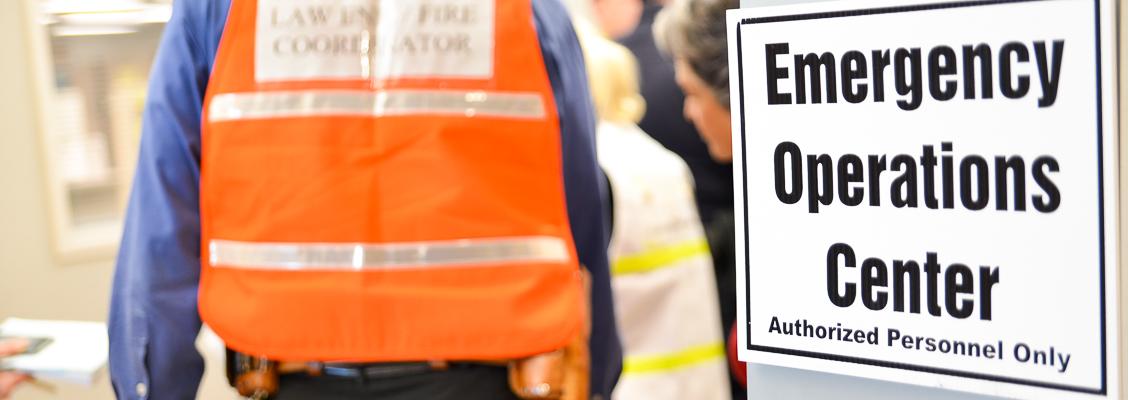It is very important that all members of the community have an emergency kit, with essential items in the event of an emergency.
The following is a suggested list of items for your home Emergency Preparedness Kit:
- Water - store one gallon of water per person per day - keep at least a three to ten-day supply of water for each person in your household. Change your stored water supply every six months so it stays fresh.
- Food - store a three to ten-day supply of non-perishable food.
- Rotate your stored foods every six months.
- Select foods that require no refrigeration or preparation.
- Ready to eat canned meats, fruits and vegetables.
- Select food items that are familiar to your children.
- Comfort/stress foods - cookies, hard candy, etc.
- High energy foods - peanut butter, crackers, granola bars.
- Manual can opener and eating utensils
- First Aid Kit with several sizes of bandages, gauze, anti-septic wipes, burn cream, topical ointments, etc.
- Prescription medications
- Light sources - flashlights and extra batteries, chemical light sticks. etc.
- Small radio and extra batteries
- Fire extinguisher
- Jacket, clothes and gloves extra pairs of shoes for each family member
- Blankets and sleeping bags
- Small tool kit containing wrenches, pocket knife, scissors
- Small mirror and whistle - for signaling help
- Toiletries and personal hygiene items
- Small tool kit
- Special items —remember family members with special needs, such as infants, elderly or disabled persons.
- Entertainment pack - family photos, notebooks, games and books
- Store your kit in a convenient place known to all family members.
- Update / refresh supplies at least every 6 months
Office & Auto Kits:
Just as you prepare a home emergency preparedness kit, you should have essential supplies at your office and/or in your vehicle:
- Bottled water
- Nonperishable food
- First aid kit
- Prescription medication
- Eyeglasses and spare contacts
- Flashlights, spare batteries
- Change of clothes and sturdy shoes
- Coins and cash
- Tools
- Blanket or sleeping bag
Be sure to plan for your pets by making emergency kits for them and plans for evacuation.
For more preparedness tips, visit the American Red Cross, Federal Emergency Management Agency or Earthquake Country Alliance websites.
Your emergency plan should include the following:
Communication Plan: Pick two meeting places - a location a safe distance from your home in case of fire and a place outside your neighborhood in case you cannot return home. Make sure each family member has a list of family phone numbers and your out-of-state contact number with them so the contact information is readily accessible.
Evacuation Plan: Prepare an evacuation plan for your home - practice it with your family and establish meeting sites. Most residential fires become overwhelming within 2 minutes, see if you can get everyone safely out within this time frame.Include your pets in the evacuation planning. Re-think your routine. When practicing your plan, you should also test smoke alarms to ensure they are functioning properly. Every residence should have an alarm in each sleeping area and in the common areas (i.e. living room).
Alternate Transportation Plan: What if your vehicle is is not available or public transportation is not working as streets are not accessible. Plan ahead so you have mapped out alternate routes and means of transportation.
Emergency Financial Plan: Stash some cash to make sure you have a sufficient amount of money to get through the emergency period. Make copies of vital personal documents and information for each family member. It’s also important to store important documents in a fireproof storage box, or safety deposit box, or freezer (make sure documents are tightly sealed), and to keep copies with an out-of-state contact. Store copies of important documents such as: Social Security cards, Birth certificates, Marriage and death records, Drivers' licenses, Insurance policies, Health history, allergies, blood types and Recent photos for I.D purposes
Unique Considerations: You should also make special provisions for children, seniors, people with disabilities, pets and you should schedule disaster drills and practice your plans.
Planning for Earthquakes: Some steps can be taken in advance of earthquakes to ensure your home and work environments are as safe as possible:
- Keep breakables, heavy objects, and flammable or hazardous liquids in cabinets or secured on lower shelves.
- Secure mirrors, framed pictures and other objects with closed hooks so they can't bounce off the wall.
- Secure TVs and entertainment centers with straps.
- If possible, bolt bookcases and other furniture pieces to the wall.
- Visit the Earthquake Country Alliance website for more ways to secure your home.
- Secure your water heather and major appliances.
- Know how to shut off your utilities.
- Know the danger spots in your house and know the safest spots in your house.
- Secure the tops of all top-heavy furniture to a wall.
- Remember - if it is taller than it is wide - Secure it!
- Know all the possible ways to exit your home in an emergency.
To stay informed during an emergency, ensure that you have a functioning radio with extra batteries. The Emergency Alert System can be monitored on KNX 1070AM or KABC 790AM for regional news. At CSUN you can stay informed through our emergency communications systems. At home, you can stay informed through your own County emergency notification system.
- Los Angeles County: Sign up for Alert LA County here.
- Ventura County: Sign up for VC Alert here.
You can also stay informed before an emergency by signing up for CSUN's free emergency preparedness training sessions, or becoming a member of our campus CERT team.

